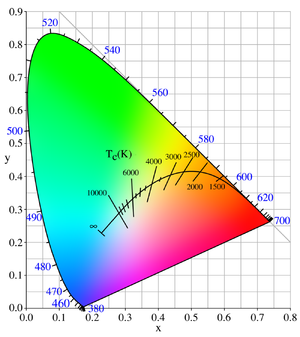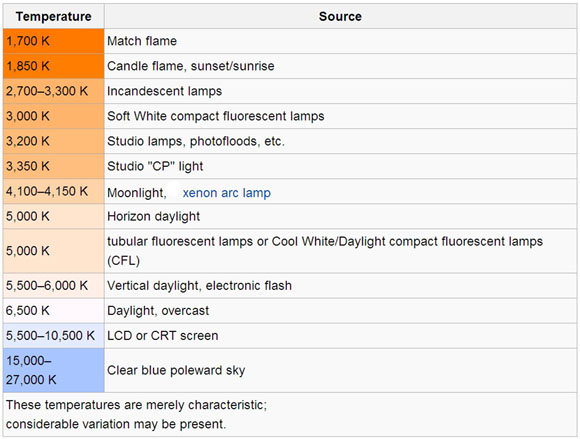Color temperature is a characteristic of visible light that has important applications in lighting, photography, videography, publishing, manufacturing, astrophysics, horticulture, and other fields. The color temperature of a light source is the temperature of an ideal black body radiator that radiates light of comparable hue to that of the light source. In practice, color temperature is only meaningful for light sources that do in fact correspond somewhat closely to the radiation of some black body, i.e. those on a line from reddish/orange via yellow and more or less white to blueish white; it does not make sense to speak of the color temperature of e.g. a green or a purple light. Color temperature is conventionally stated in the unit of absolute temperature, the kelvin, having the unit symbol K.
Color temperatures over 5,000K are called cool colors (blueish white), while lower color temperatures (2,700–3,000 K) are called warm colors (yellowish white through red).This relation, however, is a psychological one in contrast to the physical relation implied by Wien's displacement law, according to which the spectral peak is shifted towards shorter wavelengths (resulting in a more blueish white) for higher temperatures.

The CIE 1931 x,y chromaticity space, also showing the chromaticities of black body light sources of various temperatures (Planckian locus), and lines of constant correlated color temperature.
Categorizing different lighting

The color temperature of the electromagnetic radiation emitted from an ideal black body is defined as its surface temperature in kelvins, or alternatively in mired (micro-reciprocal kelvins). This permits the definition of a standard by which light sources are compared.
To the extent that a hot surface emits thermal radiation but is not an ideal black body radiator, the color temperature of the light is not the actual temperature of the surface. An incandescent lamp's light is thermal radiation and the bulb approximates an ideal black body radiator, so its color temperature is essentially the temperature of the filament.
Many other light sources, such as fluorescent lamps, emit light primarily by processes other than thermal radiation. This means the emitted radiation does not follow the form of a black body spectrum. These sources are assigned what is known as a correlated color temperature (CCT). CCT is the color temperature of a black body radiator which to human color perception most closely matches the light from the lamp. Because such an approximation is not required for incandescent light, the CCT for an incandescent light is simply its unadjusted temperature, derived from the comparison to a black body radiator.





